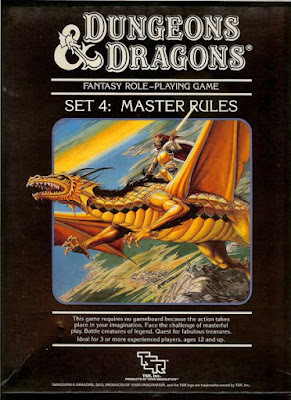Retrospective: Dungeons & Dragons Master Rules
 Over the years I've written this blog, I've been a consistent critic of what I call "kiddie D&D" – my name for the version of the game developed by Frank Mentzer, starting with the 1983 Basic Rules boxed set. Whatever my feelings on the matter, there's no question that this version was immensely successful. According to some reports (and Mentzer's boasts), TSR sold more copies of kiddie Dungeons & Dragons than any other published during the company's existence. I can believe it too, judging by the large number of gamers just a little younger than myself who look on these boxed sets with a great deal of fondness.
Over the years I've written this blog, I've been a consistent critic of what I call "kiddie D&D" – my name for the version of the game developed by Frank Mentzer, starting with the 1983 Basic Rules boxed set. Whatever my feelings on the matter, there's no question that this version was immensely successful. According to some reports (and Mentzer's boasts), TSR sold more copies of kiddie Dungeons & Dragons than any other published during the company's existence. I can believe it too, judging by the large number of gamers just a little younger than myself who look on these boxed sets with a great deal of fondness.
Ultimately, Mentzer's D&D consisted of five boxed sets: Basic, Expert, Companion, Master, and Immortals. I actually think rather highly of the Companion Rules, but the same cannot be said of its immediate follow-up, the Master Rules, first published in 1985. According to the set's introduction, the Master Rules deal with "the ultimate level of might and glory" (levels 26–36). This would seem to mean that characters at this level are akin to mythological heroes who regularly interact with the gods (called "immortals" throughout this set) and will, in fact, one day join their ranks. I don't find this focus particularly compelling, but it's one with which D&D has toyed in the past. Deities & Demigods, for example, addresses this matter briefly and I remember hearing about campaigns in my youth in which player characters achieved godhood.
The boxed set consists of two rulebooks, one for players and one for the Dungeon Master. The Players' Book consists of three main sections. The first deals with character classes, providing rules expansions to handle levels up to 36. This material is absurd in my opinion. The numbers involved in everything, from hit points to saving throws to the combat charts, are such that one wonders whether it's even worth rolling to determine success. More than that, the mechanical acrobatics necessary to make demihuman characters, who reached maximum level all the way back in the Expert Rules, are laughable. That alone makes me question the wisdom of ever producing these rules. The second section introduces "weapon mastery" rules, a complex system of weapon specialization that requires the use of a very complicated table. The third section introduces rules for sieges for use with the "War Machine" mass combat system in the Companion Rules.
The DM's Book likewise has three sections, the first of which details a variety of rules expansions and additions. One of these introduces "mystics," which are a new character class similar to AD&D's monk. It's in this section that we also get an overview of the various paths to immortality available to characters and that will be expanded upon in the next boxed set. The second section is filled with absurdly powerful monsters, while the third focuses on artifacts. There's also a map of the entirety of the "Known World" setting (later dubbed Mystara), which I imagine piqued many gamers' interest at the time, since we'd never seen anything like it prior to this point.
All in all, the Master Rules are a mess. They seem to exist solely to fill in a gap in the progression toward the Immortal Rules rather than being based on a clear thematic need. The Basic Rules, for example, focus on dungeon adventures, while the Expert Rules expand organically from that toward wilderness exploration. From there, we get domain rulership in the Companion Rules, which is a logical progression. But the Master Rules? What do they offer in this progression? Is preparation for godhood the next logical step? Even if it is, the bigger problem is that rules, as presented here, break down, with new real way to challenge characters whose "to hit" rolls and saving throws are so low and whose hit point totals so high. Mind you, I'm not sure anyone ever played campaigns at such high levels, so the whole matter may be academic in the end.
James Maliszewski's Blog
- James Maliszewski's profile
- 3 followers



